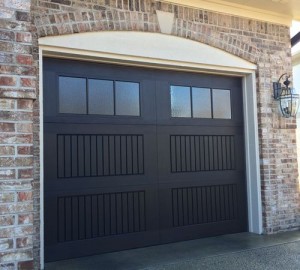
Insulated garage doors are an effective way to help regulate the temperature of your garage space and reduce energy costs. They can also protect your belongings and keep out harsh weather conditions and noise. It doesn't matter if your goal is to replace or install a door, it's important that you choose the right insulation.
Radiant barriers are the best and most affordable form of garage door insulation. Radiant barriers are half the price of foam kits. You can simply attach the kit using plastic clips once it is installed. This type of door insulation will keep your garage cool in the summer and warm in the winter.
Polyurethane, another popular garage door insulation option is also available. Polyurethane is an extremely dense and fire-resistant material that is sprayed into the door frame. It's more durable than polystyrene but has many additional advantages. Polyurethane is a thermal insulator and can withstand temperatures up 700 degrees Fahrenheit.

Insulated glass garage door are a premium option. These doors are a modern and popular design. They can increase curb appeal and add value to your home. They also let in lots of natural sunlight. They are also great for reducing noise levels and dampening street traffic.
One of the most striking features of an insulated door for garages is its ability control temperature. It keeps your garage at a consistent temperature which is important for food storage. An insulated garage door can ensure that your family's food remains fresher for longer and that your cars don't get damaged from temperature fluctuations.
Insulated garage doors also make it easier to keep your garage cool during summer. During the hot months, the lingering moisture in the air can increase humidity levels and cause mold to form. Your possessions can be damaged if the garage is connected to your home.
Here are some tips to help you decide whether or not you need an insulation garage door. If the door isn't being used, make sure it is locked. Second, be sure to insulate the roof and floor of your garage. Insulate your walls as well. Fourth, and final, if you have the funds, insulate your walls.

Using the right type of insulation for your door will save you money, time, and stress. It can also be an exciting DIY project that the whole family can enjoy. When you're ready to upgrade your door, you can go through the process yourself or hire a professional. You have the option of customizing your door, like a stainedglass window.
FAQ
How do I know if my house is in need of a renovation?
You should first check to see if your home has had any recent updates. If you haven't seen any updates for a few years, it may be time to consider a renovation. On the other hand, if your home looks brand-new, then you may want to think about a remodel.
A second thing to check is the condition of your house. It's possible to renovate your home if there are holes in the walls, peeling wallpaper or damaged tiles. However, if your home looks great, then maybe it's time to consider a remodel.
The general condition of your home is another important factor. Is your house structurally sound? Are the rooms clean? Are the floors well-maintained? These are crucial questions when deciding on the type of renovation to do.
What is the difference between renovation and remodel?
Remodeling is any major transformation of a room or portion of a bedroom. A renovation is a minor change to a room or a part of a room. A bathroom remodel, for example, is a major undertaking, while a new sink faucet is minor.
Remodeling involves the complete or partial renovation of a room. Renovating a room is simply changing one aspect of it. For example, a kitchen remodel involves replacing counters, sinks, appliances, lighting, paint colors, and other accessories. You could also update your kitchen by painting the walls, or installing new light fixtures.
Are there any savings on a remodel of a bathroom or kitchen.
Remodeling a bathroom and kitchen can be costly. But considering how much money you spend on energy bills each month, it might make more sense to invest in upgrading your home.
It is possible to save thousands every year with a simple upgrade. A few small changes, such adding insulation to walls or ceilings, can cut down on heating and cooling costs. Even a simple addition can increase comfort and reduce resale costs.
Remember to choose durable and easy-to maintain products when you are planning your renovations. Solid wood flooring, porcelain tile, and stainless steel appliances last longer than vinyl and laminate countertops and require less maintenance.
You might find that upgrading to newer fixtures can cut down on utility costs. Low-flow showerheads or faucets can help reduce water usage by up 50 percent. You can reduce your electricity consumption by replacing inefficient lighting bulbs with compact fluorescent lights.
How much does it cost to gut and renovate a kitchen completely?
You might be wondering how much it would cost to renovate your home.
The average kitchen remodel costs between $10,000 and $15,000. However, there are ways to save money while improving your space's overall look and feel.
Planning ahead is a great way to cut costs. This includes choosing a style and color scheme that suits your lifestyle and finances.
You can also cut costs by hiring an experienced contractor. A professional tradesman knows exactly how to handle each step of the construction process, which means he or she won't waste time trying to figure out how to complete a task.
It would be best to consider whether you want to replace or keep your existing appliances. Remodeling a kitchen can add thousands of pounds to its total cost.
It is possible to choose to buy used appliances, rather than buying new ones. A used appliance can help you save money as you won't be charged for installation.
Last but not least, shopping around for materials or fixtures can help you save some money. Many stores offer discounts for special occasions like Cyber Monday or Black Friday.
What would it cost for a home to be gutted versus what it would cost to build one?
A home gutting involves the removal of all interior items, including walls, floors ceilings, plumbing and electrical wiring, fixtures, appliances, and fixtures. It is often done when you are moving to a new location and wish to make some improvements before you move in. Because of the many items involved in gutting a house, it is usually very costly. Depending on your job, the average cost to gut a home can run from $10,000 to $20,000.
Building a home means that a builder constructs a house piece by piece, then adds windows, doors, cabinets and countertops to it. This is typically done after purchasing lots and lots of lands. Building a home is normally much less expensive than gutting, costing around $15,000-$30,000.
It all comes down to what you want to do in the space. You'll need to spend more if you plan to gut your home. But if your goal is to build a house, you won't need to disassemble everything and redo everything. Instead of waiting for someone to tear it down, you can make it exactly how you want.
In what order should you renovate a house?
The roof. The plumbing follows. Third, the electrical wiring. Fourth, the walls. Fifth, the floors. Sixth, are the windows. Seventh, the door. Eighth, is the kitchen. Ninth, the bathroom. Tenth, the garage.
After all the above, you are now ready for the attic.
It is possible to hire someone who knows how to renovate your house. You will need patience, time, and effort when renovating your own home. You will also need to spend money. So if you don't feel like putting in the hours or the money, then why not let someone else do the hard work for you?
Renovations aren't cheap, but they can save you tons of money in the long run. It's also a way to make your life more pleasant.
Statistics
- Following the effects of COVID-19, homeowners spent 48% less on their renovation costs than before the pandemic 1 2 (rocketmortgage.com)
- $320,976Additional home value: $152,996Return on investment: 48%Mid-range average cost: $156,741Additional home value: $85,672Return on investment: (rocketmortgage.com)
- 5%Roof2 – 4%Standard Bedroom1 – 3% (rocketmortgage.com)
- About 33 percent of people report renovating their primary bedroom to increase livability and overall function. (rocketmortgage.com)
- According to a survey of renovations in the top 50 U.S. metro cities by Houzz, people spend $15,000 on average per renovation project. (rocketmortgage.com)
External Links
How To
How to Remove Tile Grout from Floor Tiles
Most people don't know that tile grouting exists. It is used to seal the joints between the tiles. There are many types available today. Each is used for a specific purpose. This article will teach you how to remove tile grout off floor tiles.
-
Before you start this process, make sure that you have all the necessary tools. It would be best if you had a grout cutter, a grout scraper, and some rags.
-
You will now need to clean off any dirt and debris that may have been under the tile. Use the grout cutter to cut away at the grout and gently scrape away any loose pieces. You must be careful not to scratch any tiles.
-
After you've cleaned up everything, grab the grout scraper to remove any grout. You can move on to step 4 if there is no grout left.
-
Now you can get on with the next step. Take one of the rags and soak it in water. The rag should be completely dampened. To ensure that the rag does not absorb water, dry it.
-
Place the wet rag onto the joint where the tile meets the wall. Continue pressing down on the rag until you see the grout begin to fall apart. Slowly pull your rag towards yourself and continue to pull it back and forth, until all grout is gone.
-
Continue to repeat steps 4 and 5, until all grout has been removed. Rinse and repeat the procedure if necessary.
-
Once you have finished removing all the grout, wipe down the surface of the tiles with a damp cloth. Let dry thoroughly.